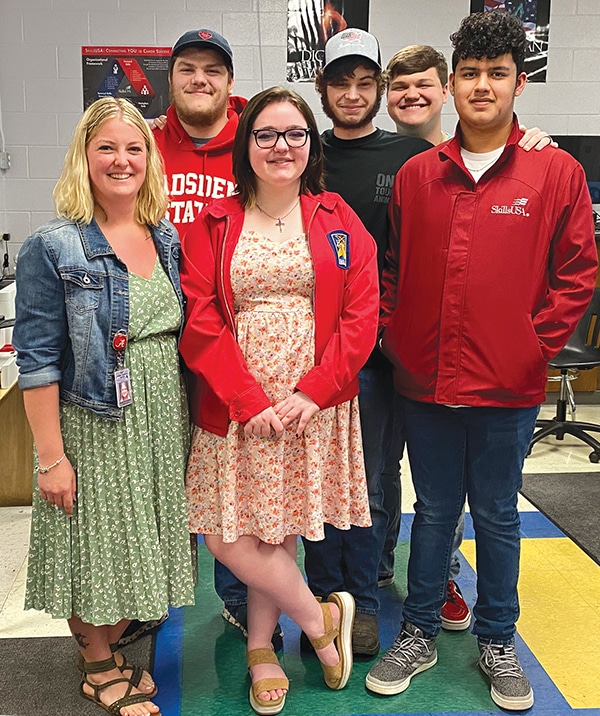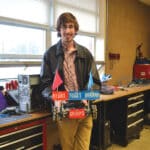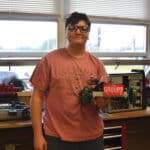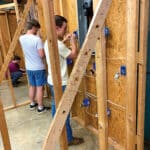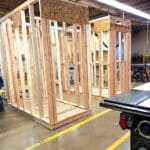Photo: Engineering Design Instructor Ashley Strawderman (left) poses for a photo with her senior students during the Etowah Career Technical Center open house March 30. (Emma Kirkemier/Messenger)
By Emma Kirkemier, News Editor
Etowah County Career and Technical Center held an open house on March 17, showcasing its 10 programs for parents and prospective students.
The career and technical center offers courses in automotive technology, collision repair technology, computer science, construction technology, electrical technology/industrial automation, electronics/robotics, engineering design, health science, precision machining and welding technology.
Each program instructor outlined their program curriculum and outcomes, but their students ultimately took the lead in the exhibition. Several students demonstrated class projects, and officers like Alabama SkillsUSA Vice President GraceAnn Dean, a senior in the engineering design program, served as official tour guides.
“If I can get the students to be the ambassadors, then that’s even better than anything I can say,” said Etowah County Career Technical Center Principal Mark Stancil.
The center focuses on career readiness by teaching its students practical, mostly trade-specific skills.
“All of it’s practical,” Dean said. “And they’re all good shops.”
The robotics lab was filled with various electronics, including a table supporting several robot arms that performed simple motor tasks. Students learned to program and pilot these in preparation for mechanical or manufacturing industry experience.
“I’m hoping I can get them a head start,” said Electronics/Robotics Instructor Adam Blackerby.
Student Brady Simmons conducted a sample presentation of the arms, as well as showing off his group’s wheeled robot, currently in the lead in a class-wide, tournament-style competition to build the fastest remote-controlled vehicle.
In the health science classroom, students demonstrated CPR on mannequins.
“The first year they all learn basic vital signs, so we do height and weight, blood pressure, heart rate and oxygen saturation, respiration,” said Health Science Instructor Dr. Susan Thrasher. “They learn how to make the bed correctly and handle the linens. We do bed baths; we do patient positioning. We do EKGs.”
The far side of the classroom was lined with hospital beds, where students practiced treating both mannequins and each other.
“I’ll do the didactic portion and I’ll introduce, for example, the bones of the cranium, and then we’ll go to the clinical side and we’ll take care of a 17-year-old that has a traumatic brain injury,” Thrasher said. “They have to know how to do the ACE, the Acute Concussion Evaluation. They have to know how to do the Glasgow Coma Scale, so they practice. They’re viewing each other’s eyes to see if the pupils change. Hopefully I bring a lot of life experience, because that makes it real.”
“We do a lot of hands-on work in here,” said Electrical Technology/Industrial Automation Instructor Mark Lacey. “When they come in, they know exactly what they’ve got to do Monday through Friday. I try to make it as much like industry (work) as I possibly can, but they’re learning as they’re going.”
Several students were working at circuit boards, each station specialized to either residential or industrial wiring.
“We go through two career pathways here,” Lacey said. “We can either go into electrical construction wiring, or we go into industrial maintenance.”
He explained that both paths have dual enrollment options through Gadsden State Community College, which many students take.
“We do a lot of industrial motor controls like we have here, and we do a lot of hydraulics and HVACs,” Lacey said. “We do a lot of mechanical wiring. We do a lot of EMT conduit bending; we do a lot of residential and commercial wiring. We do a little bit of it all.”
The construction technology program, formerly the cabinetry program, also does a little bit of everything.
“Pretty much everybody on campus has something we’ve built that they use,” said Construction Technology Instructor Lynn White.
The students worked in groups on tiny homes, but side projects have included boxes for local Special Olympics podiums, garbage bag hangers for other shops and feral cat homes for the Second Chance Animal Shelter.
“These tiny homes they’re building (will) teach them how to frame in a doorway and a window,” White said. “Next they’ll be putting up some walls and framing the interior walls. At the end of the school year, they’ll start to tear it down, and then start it over the next year.”
Engineering Design Instructor Ashley Strawderman came through the engineering program herself as a student before she returned to the technical school as a teacher.
“Our everyday assignments for drafting teach them how to use 2D and 3D CAD (computer-aided design),” Strawderman said. “Everyone learns first on 2D; it’s the easiest to learn with.”
Students learn drafting and blueprint design by designing programs and projects that have previously included a catapult, a 3D-printed chess set, a model bridge, a chocolate mold and a host of other objects.
“One thing great about my shop is I can collaborate with almost everyone,” Strawderman said. “Robotics has came to us (saying), ‘Hey, can you print us this gear? We really want to make it go faster.’ Or carpentry will say, ‘Hey, we’re building cabinets; can you draw up this plan for me?’ Automotive might say, ‘Hey, can you pull up this schematic for me?’”
Some of the shop’s students are multidisciplinary, applying their drafting skills to construction, design or machining.
“Cameron over here, he’s taking precision machining as well,” Strawderman said. “He’s been taking my drafting classes for three years now, and this year he’s split between precision machining and my class. He’s working in between. He actually can design it and build it out of metal.”
In the computer lab, Computer Science Instructor Kevin Fathi introduces students to coding and programming.
“I have about 45 in my shop, so we’re among the smaller of the shops here,” Fathi said. “When we first started this back in fall of 2020, I think we had eight to 10 to start with. Of course, we only offered one or two courses, but we’ve grown.”
Now the program’s course offerings include programming essentials, introduction to cybersecurity and courses in programming languages like python and java.
According to Fathi, computer science students also have opportunities to participate in programming and cybersecurity competitions, which were held this year at the University of Alabama and at UAB, as well as Governor Kay Ivey’s app challenge, which invites students to submit their created phone and tablet apps.
Student Josiah Odell demonstrated a program of his own called Bean Tycoon, an idle clicker game and a personal project that Odell coded entirely on his own.
“I’ve already completed the basic course work, and since there is nothing that I want to do being offered, I’ve decided to do my own thing,” Odell said. “Personally working on your own project is the best way to learn, so that’s what I’m doing.”
According to Precision Machining Instructor Adam Talley, programming also falls within his program’s wheelhouse.
“We teach hand coding to program these machines, and we also teach software to program these machines,” he said. “We teach manual machining processes through mills and blades, and we teach CNC coding, which is automated machinery that make and produce parts repeatedly and accurately every single time. We end up going from CNC blades, mills, up to five-axis machining or higher.”
Precision machining students study the practical operation of machines as well as skills like metallurgy, which Talley explained involves discerning which metals, compositions and cutting tools are best for a certain project.
“Machining is the process of cutting, forming, shaping metals and other materials into precise and accurate forms,” Talley said. “Everything in modern society would not exist without us that’s nonorganic, from the glasses you’re wearing, the pen you’re using, your shoes, Crocs, bracelets, LEGOs, anything you can imagine or think of that’s nonorganic, we have a hand in it whether you knew it or not. And that’s kind of what we’re teaching here.”
Welding is one of the largest concentrations with 63 students.
“Here at the high school level, we start with SMAW welding, and we progress from the very beginning all the way to pipe and tube welding,” said Welding Technology Instructor Cody Thomas. “Then it gets into a little bit more technical stuff, and that really flows into the college curriculum.”
Thomas teaches dual enrollment classes at Gadsden State three nights a week, which 34 of his high school students attend. Some students begin working in the industry even before graduating.
“I really take pride in my shop,” Thomas said. “I’m very proud of the program that I have, and it’s only possible because of the students. The leadership that I have here and the students that I have, they really make it easy for me to brag like this.”
In the automotive shop, instructors Floyd Hooper and Shawn Hill run the automotive technology and collision repair programs, respectively.
“So on my side (in collision repair), we teach masking, taping, sanding, metalwork, filler work, welding, parts replacement, priming and then application and refinishing materials,” Hill said.
Automotive students, on the other hand, focus primarily on live work. The shop charges 30 percent above the cost of parts, and according to Hooper, they “stay booked up” with work.
“Normally we have in-house projects that the school owns, like that Blazer that Mr. Hooper’s got over there,” Hill said. “That’s one that the school has bought. Both programs are going to work on that. Then we have donations, and we have student vehicles.”
“I’ve got four or five school cars that we use for training, and the rest of it’s just live work,” Hooper said. “We do some classroom work and online classes and stuff like that, also, to help prepare for ASE testing.”
Students in the collision repair and automotive shops have the opportunity to earn Automotive Service Excellence, or ASE, certifications. There are eight student certifications available, covering areas like maintenance and live repair, steering, suspension and engine performance.
Hill and Hooper focus on career readiness for their students, many of whom are employed right after high school.
“There’s just people looking for employees like crazy, so it’s really not hard to place them,” Hill said. “Some of mine go to Lawson State or Gadsden State. Some of them go straight to a dealership.”
Hooper noted that with vehicles becoming more and more complicated and sophisticated, students often need to seek further education, but their high school work prepares them for whatever path they choose.





